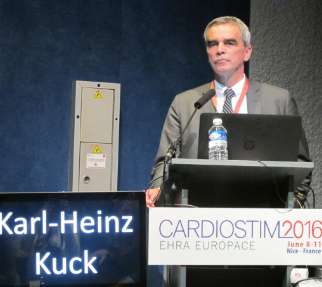
New data from the FIRE AND ICE clinical trial have shown significantly fewer repeat ablations and lower hospitalisation rates for patients with paroxysmal atrial fibrillation treated with cryoballoon ablation compared to radiofrequency ablation.
The results were presented by Karl-Heinz Kuck at a late-breaking session at CARDIOSTIM-EHRA EUROPACE (8‒11 June, Nice, France).
Primary results from the FIRE AND ICE trial, presented in April, also by Kuck, at the American College of Cardiology 65th Annual Scientific Session and published in The New England Journal of Medicine, showed comparable safety and effectiveness of cryoballoon ablation (using the Artic Front catheters, Medtronic) and radiofrequency ablation (using the Thermocool family of catheters, Biosense Webster). This is the largest randomised trial performed to date on this setting.
Predefined secondary endpoints presented at CARDIOSTIM-EHRA EUROPACE include repeat ablations, cardiovascular-related hospitalisations and quality of life. Other analyses focused on all-cause hospitalisations and direct current cardioversion.
A total of 762 patients underwent randomisation (378 assigned to cryoballoon ablation and 384 assigned to radiofrequency ablation) in eight European countries and 16 centres from January 2012 to January 2015. Sixty three per cent of patients in the radiofrequency ablation group were male and 59% in the cryoballoon ablation group were male.
In the secondary analyses, according to Kuck, the FIRE AND ICE trial demonstrated significant reductions in the cryoballoon group compared to the radiofrequency ablation group in areas including cardiovascular-related hospitalisations (34%) and repeat ablations (33%). Additional analyses showed 21% fewer all-cause hospitalisations and 50% fewer direct current cardioversions.
The cryoballoon group had 49 repeat ablations in 44 patients (44/374; 11.8%); the radiofrequency group experienced 70 repeat ablations in 66 patients (66/376; 17.6%) (p=0.03).
One hundred and thirty nine cardiovascular-related hospitalisations occurred in 89 patients (23.8%) compared to 203 cardiovascular-related hospitalisations, which occurred in 135 patients (35.9%) in the radiofrequency group (p<0.01).
With regard to all-cause hospitalisations, 122 patients in the cryoballoon group were hospitalised 210 times (32.6%) compared to 156 patients in the radiofrequency ablation group who were hospitalised 267 times (41.5%) (p=0.01).
Direct current cardioversion, was higher for patients treated by radiofrequency ablation (6.4%) as compared to patients treated by the cryoballoon ablation (3.2%) (p=0.04).
Quality of life was assessed every six months using the SF‒12 and EQ‒5D‒3L questionnaires. Results from the trial showed that quality of life improved at six months in both groups and was maintained throughout 30 months.
In conclusion, Kuck said: “The secondary analyses of FIRE AND ICE favours cryoballoon over radiofrequency ablation, with important implications on daily clinical practice.”









